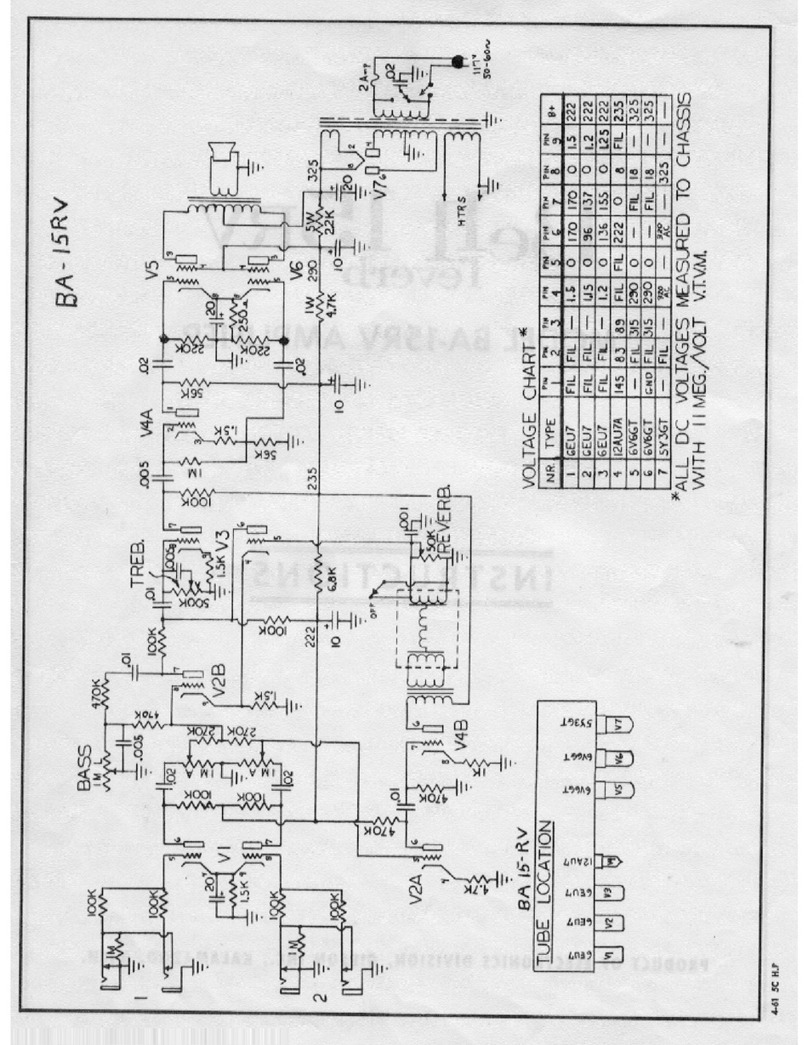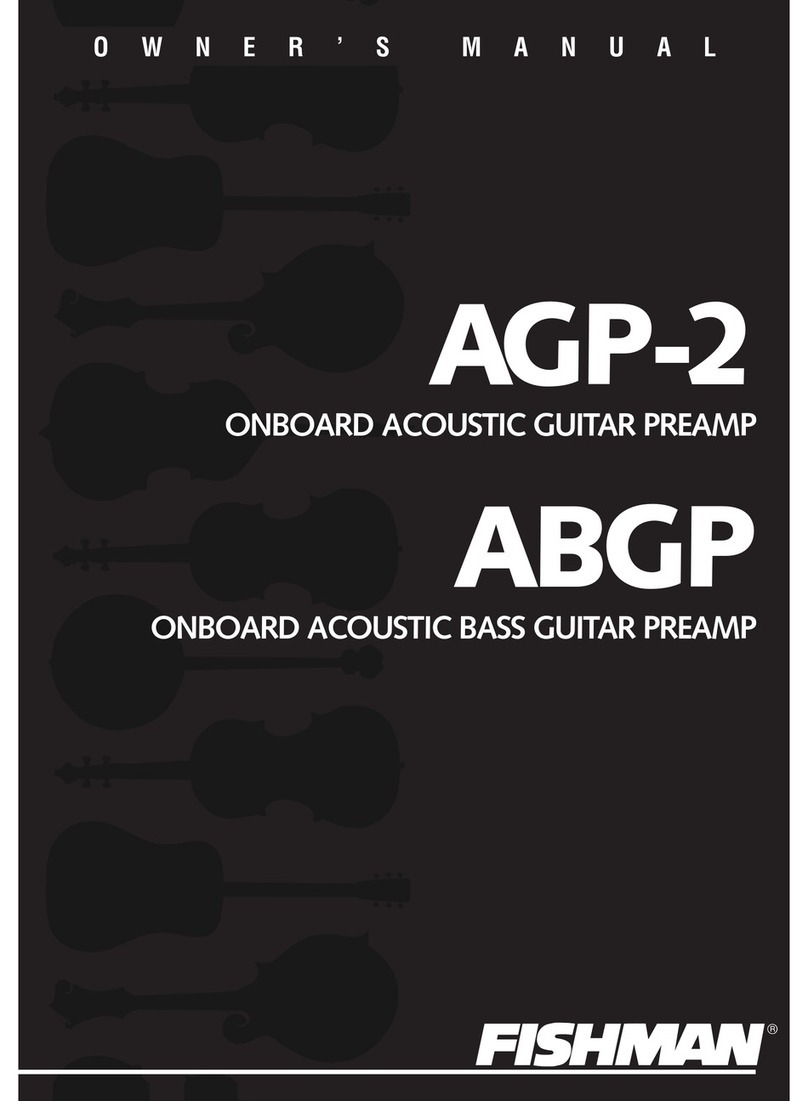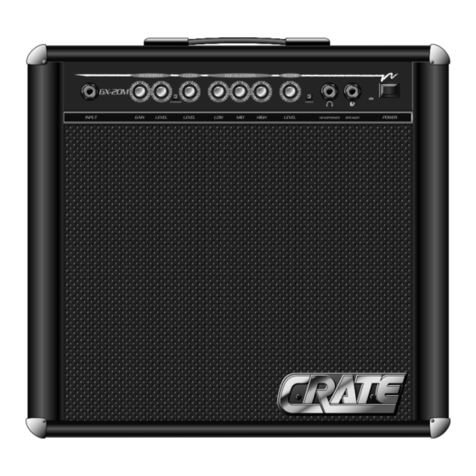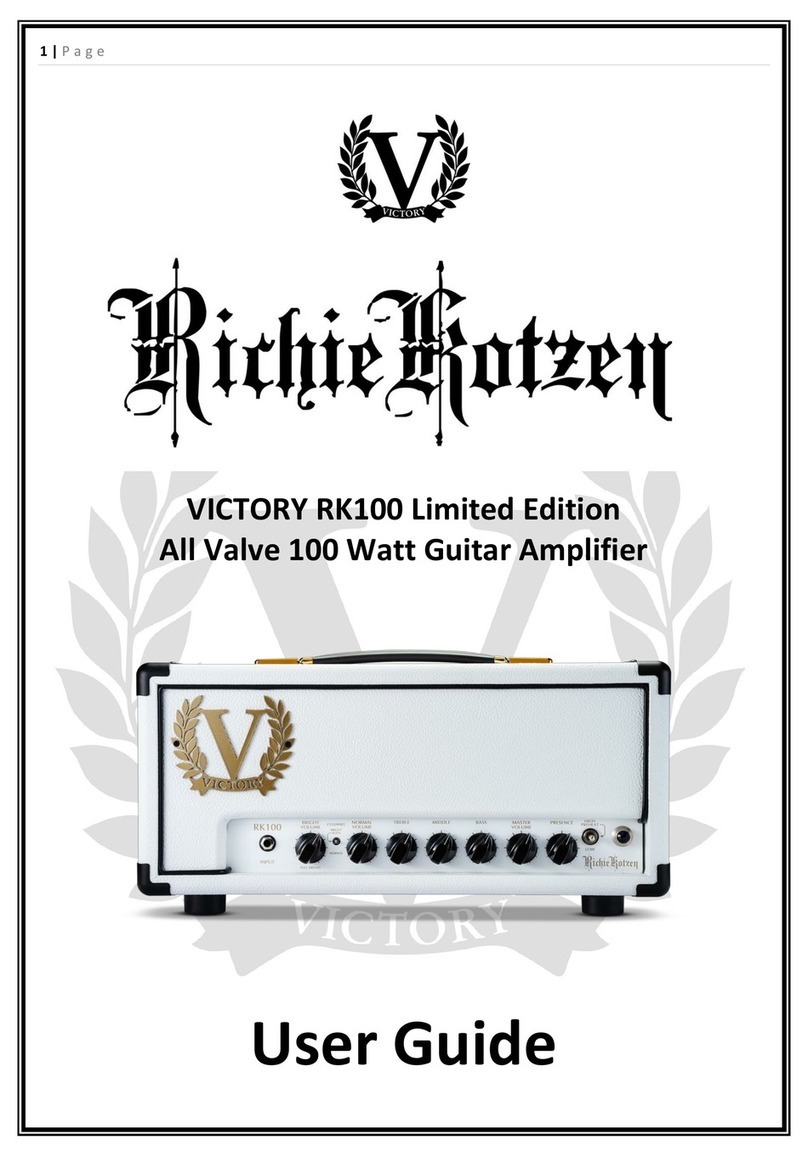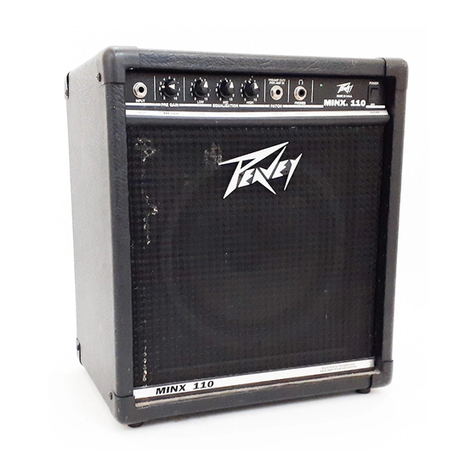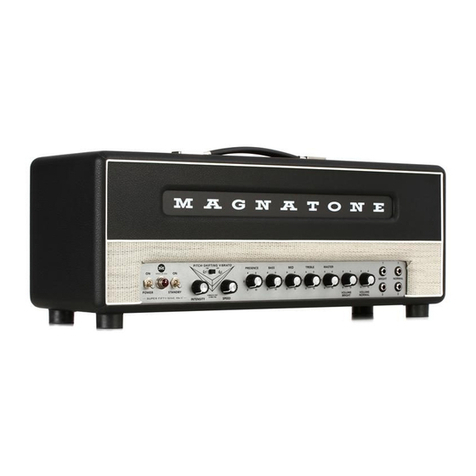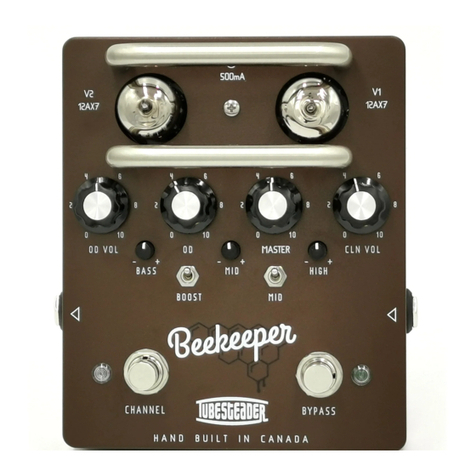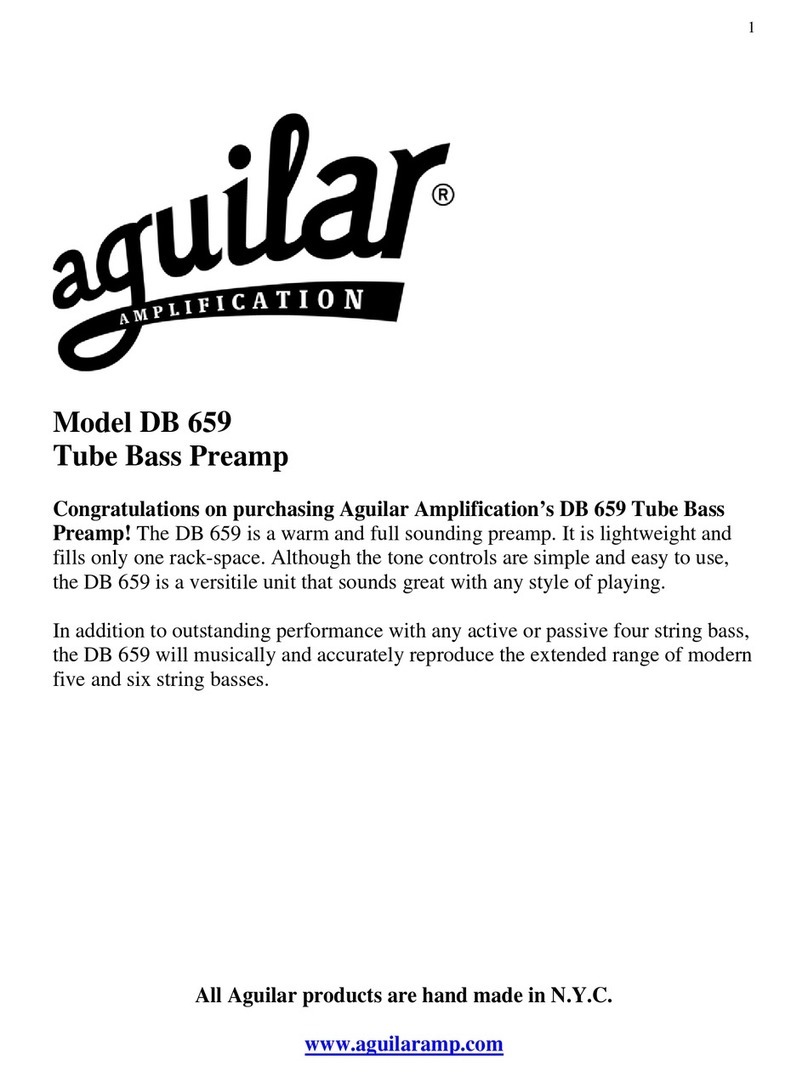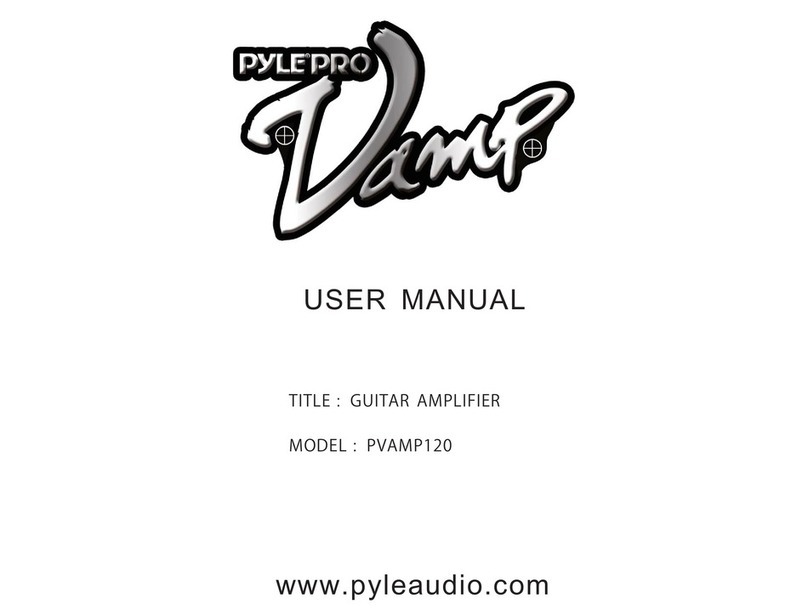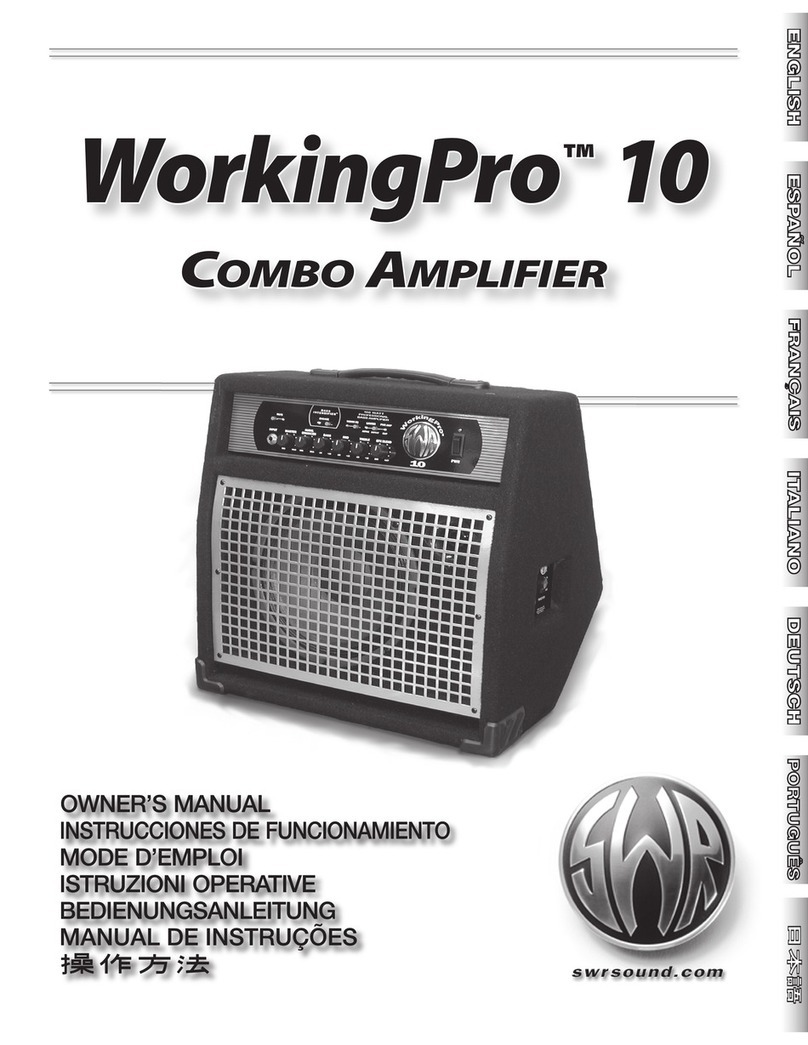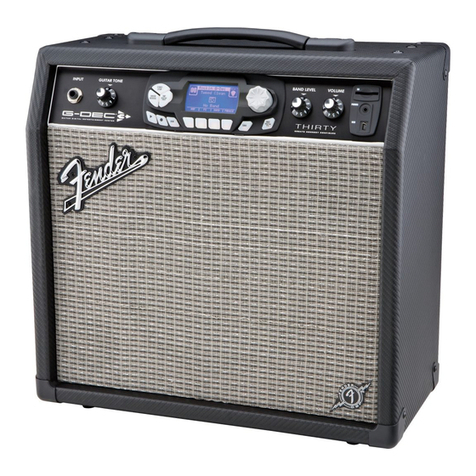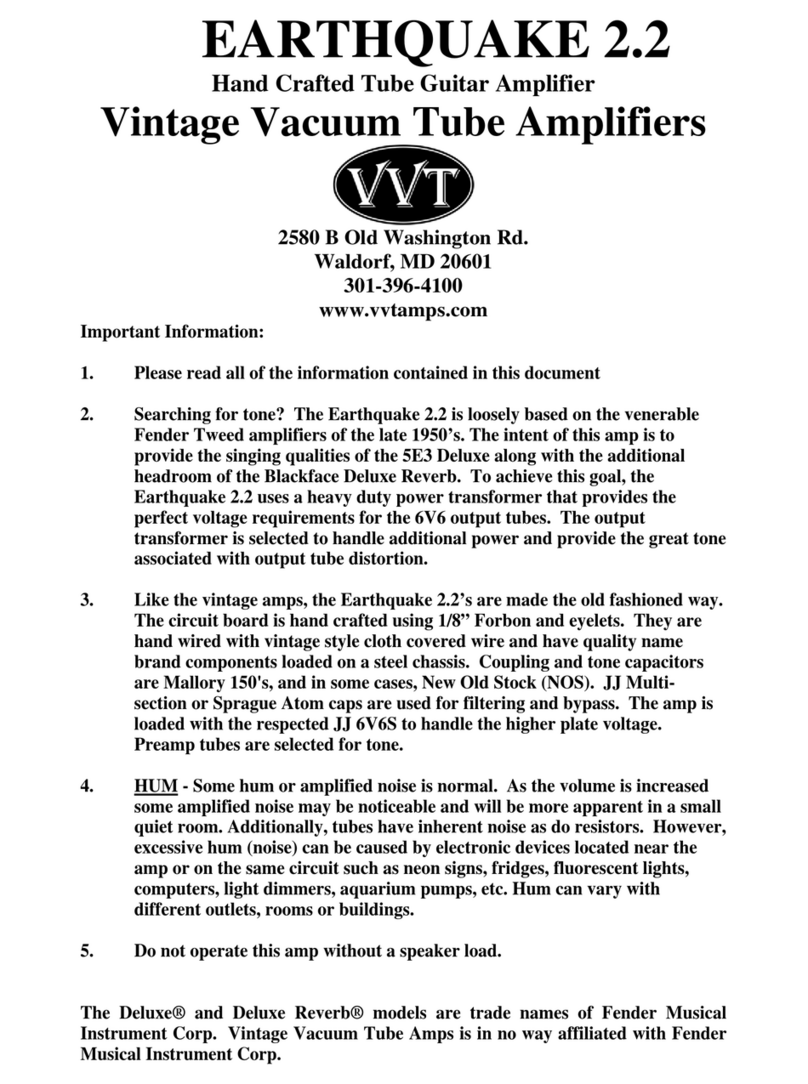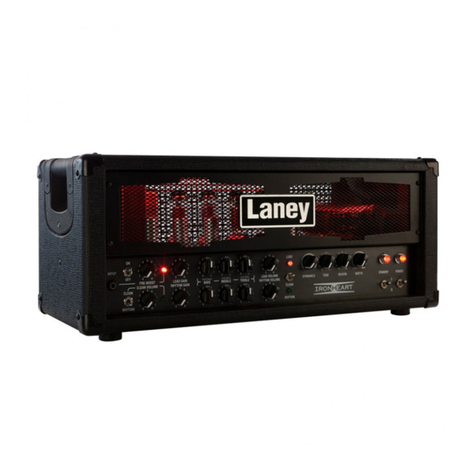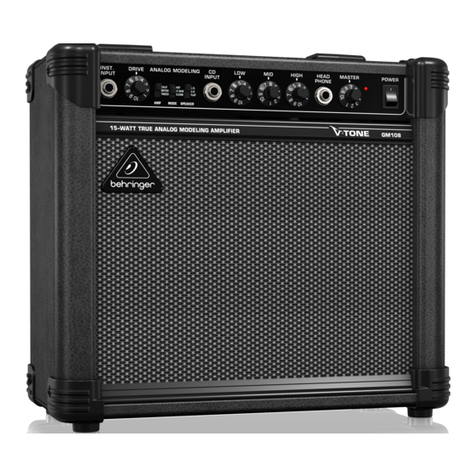Glab Guitar System Controller User manual

User Manual
Guitar
System
Controller


1
Table of contents
IMPORTANT SAFETY INSTRUCTIONS 2
EMC/EMI & CERTIFICATE OF CONFORMITY 2
PACKAGE CONTENT 4
STRUCTURE 4
PRESET SELECTION 5
BANK SELECTION 5
SILENT TUNING (MUTE) 5
LOOPS DIRECT SWITCHING MODE 6
PRESET PROGRAMMING 6
LOOP (LOOP1 TO LOOP4) AND VOLUME PROGRAMMING 6
AMP SETTINGS PROGRAMMING 6
MIDI PROGRAM NO. PROGRAMMING 7
PRESET’S COPYING 7
SETTINGS 7
LOOP BUTTON SETTINGS 7
SWITCH BUTTON SETTINGS 8
MIDI CHANNEL SETTING 8
SECOND MIDI DEVICE CONTROL 9
EFFECTS TO LOOP1 TO LOOP4 LOOPS CONNECTING 9
AMP’S CONTROL CONNECTING 10
WAH-PAD CONNECTING 11
SECOND GSC CONNECTING 11
DISPLAYING FIRMWARE VERSION 12
SIGNAL’S PATH DIAGRAM 12
TECHNICAL PARAMETERS 12
MIDI IMPLEMENTATION CHART 13
BEFORE CALLING A SERVICE 13
DIAGRAM OF DEVICES CONNECTABLE TO THE GSC 14

2
Important safety instructions
1. Read these instructions and follow them.
2. Prevent this device against moisture or spilling liquid inside.
3. Clean only with dry cloth.
4. Do not install near any heat sources such as radiators, heat registers, stoves,
or other apparatus producing a lot of heat
5. Protect the power supply cord from being walked on or pinched.
6. Only use attachments/accessories specified by the manufacturer.
7. Unplug this device during lighting storms or when unused for long periods of time.
8. Do no open device or its power supply casing.
9. The power supply adapter should be installed in the socket outlet and disconnection
of the adapter should be easily accessible.
10. To completely disconnect from AC mains disconnect the power supply adapter from
the AC receptacle.
EMC/EMI & Certificate of conformity
EMC/EMI
This device has been designed and manufactured to conform with directives and standards in the
field of safety operations and electromagnetic interference.
This device uses and can radiate radio frequency energy and, if not installed and used in
accordance with the instructions, may cause harmful interference to radio communications. However in
spite of performing below standards there is no guarantee that interference will not occur in a particular
installation. If this device does cause harmful interference to radio or television reception which can be
determined by turning the device on and off, the user is encouraged to try to correct the interference by
one or more of the following operations:
●Reorient or relocate the receiving antenna.
●Increase the separation between the device and receiver.
●Connect the device into an outlet on a circuit different from that to which the receiver
is connected.
●Contact with the manufacturer (see: Before calling a service).
●Consult the dealer for help.
Certificate of Conformity
ELZAB S.A., ul. Kruczkowskiego 39, 41-813 Zabrze, Poland,
hereby declares on own responsibility that the following product:
GSC – Guitar System Controller
that is covered by this certificate and marked with CE 07 label conforms with following standards:
PN-EN 60065:2004 Safety requirements for mains operated electronic and related
apparatus for household and similar general use
PN-EN 55103-1:1998 Product family standard for audio, video, audio-visual and
entertainment lighting control apparatus for professional use.
Part 1: Emission.
PN-EN 55103-2:1998 Product family standard for audio, video, audio-visual and
entertainment lighting control apparatus for professional use.
Part 2: Immunity.
With reference to regulations in following directives:
73/23/EEC, 2004/108/EEC Issued in Zabrze, May 2007
Jerzy Biernat
President of the ELZAB S.A. Board of Directors

3
Dear Customer,
Congratulations for choosing our Guitar System Controller!
Thanks to functionality not offered by other similar products and high quality of manufacturing and
sound parameters it will enable you quick and without distortions switching effects, pre-amps and amps as
well as MIDI devices.
So simple switching previously programmed settings of all these devices and parameters creates
new opportunity for you to fully take advantage of the equipment collected by you.
Guitar System Controller (GSC) is the programmable switching device of effects’ loops (looper),
the amp’s switcher by footswitch input and the MIDI devices’ controller in one. By pressing just a single
footswitch it enables:
-to activate selected effects (connected to LOOP1 up to LOOP4) and to select the full or lowered
defined by analog knob volume,
-to set the amp channel (or the pre-amp one),
-to set by Program Change command the MIDI device’s program No. of work (e.g. an effects’
processor).
There are five presets (numbered from 1 to 5) in the each of 6 banks (numbered from A to F). The
GSC is equipped with the function of programming presets and the copy function of already existing
presets. The copy function enables quick “organising” presets in banks to avoid switching between banks
during the particular song is played.
To avoid the incidental changing of the presets’ settings the GSC is equipped with the memory access lock.
The GSC is equipped with the “Settings” function which allows to select the mode of working (e.g.
controlling of external devices) and this function enables to set the parameters connected with MIDI
transmission.
Basic characteristics:
-high impedance input (identical with a tube amp characteristics) based on FET transistor,
-independent guitar’s TUNER output with the silent tuning function,
-four loops for connecting single effect pedals (stomp boxes) or serially connected stomp boxes
with skipping (relay bypassing) switched off effects,
-four outputs 9V DC supplying effect pedals (totally max. 160 mA with overloading indication),
-volume change module (full or lowered defined by the analog knob) to apply in the
solo/background playing mode,
-2 outputs (2 lines each, latching type) for amp's switching by footswitch input,
-MIDI output setting the program No. of e.g. an effects’ processor (giving possibility to control
independently two MIDI units by one of their THRU outputs),
-5 footswitches to select presets,
-1 footswitch with a definable function (choice: loops direct switching mode, switching to the
previous bank, changing the volume or MUTE),
-very silent footswitches (backlighted),
-LINK connector for connecting the second GSC device to form a set with double possibilities
(working in two modes: “remote” or “nearby”),
-a possibility to connect a wah-wah effect pad (wah-pad) to control the system by placing foot on it,
-the main signal output giving possibility to connect parallely several amps using a long cable
(10 meters) without signal quality loss,
-external power supply with a long ( 3.5 meters) and flexible cable which eliminates a power
supply presence on the floor and provides increased safety level.

4
Package content
Guitar System Controller unit - Product code 00519
GSC power supply adapter - Product code 01597 - for Europa market, or
Product code 01598 - for US market
Two 9V 40 cm cables - Product code 00805
Two 9V 80 cm cables - Product code 00806
User’s Manual
Structure
1 - Preset footswitches from 1 to 5
2 - OUT 9V DC output’s overloading indicator (effect’s power supply)
3 - Voltage failure indicator (voltage below 11V or above 15V)
4 - Activated loops’ (LOOP1 to LOOP4) indicators (lit when a loop is ON)
5 - SW1 to SW4 outputs’ status indicators
6 - Presets indicators
7 - LOOP programming button
8 - Banks indicators
9 - SWITCH programming button
10 - Memory access LOCK indicator
11 - MIDI programming button
12 - DEF footswitch with definable function
13 - Lowered volume control analog knob
14 - Memory access lock switch
12
1
2
3456
7
8910
11
13
14

5
1 - MIDI OUT – MIDI output connector
2 - IN – guitar input connector
3 - TUNER – guitar tuner connector
4 - OUT – amp’s signal output connector
5 - LINK – the second GSC (to form a set) and/or the wah-pad connector
6 - SEND – effect’s loop output connector
7 - OUT 9V DC – effect’s power supply connector
8 - RETURN – effect’s loop input connector
9 - OUT SW1&2 – output connector for amp's switching by footswitch input
10 - POWER 12V DC – 12V power supply connector
Preset selection
Press shortly (less then 1 second) the preset footswitch numbered from 1 to 5 (the selected
preset’s indicator will be lit).
Bank selection
Press and keep (more then 1 second) the preset footswitch numbered from 1 to 5 or the DEF
footswitch (bank indicators: continuos lit means A, B or C bank enabled, blinking means D, E or F
bank enabled).
REMARK:
During switching banks adequate preset will be enabled for 1 second and later it will return to the
previously selected preset. It is recommended to program presets in banks in such a way that all
necessary presets used in a particular song will be located into just one bank or it is recommended
to use DEF footswitch for switching between latest used banks.
Silent tuning (MUTE)
Press at the same time preset footswitch No. 1 and No. 2 (all presets’ indicators will start to blink).
In case of using DEF footswitch as a silent tuning one (see: LOOP button settings) press DEF
footswitch.
To exit from MUTE press the preset footswitch intended to be used.
1234
5
678
9
10

6
In case of using DEF footswitch as a silent tuning one (see: LOOP button settings) press the
preset footswitch intended to be used or press DEF footswitch (return to the previous preset).
Loops direct switching mode
Set DEF footswitch as the loop direct mode switch (see: LOOP button settings).
Select adequate preset and press shortly DEF footswitch (preset indicator starts to blink and
LOOP indicator starts to light).
Following pressing any preset footswitch will effect in consequent enabling and disabling (toggling)
loops numbered from 1 to 4 and the volume change.
Press DEF footswitch to return from the loops direct switching mode (preset indicator starts to light
and LOOP indicator stops to light).
The preset modified in this way will not be saved (next calling of the preset will restore its
parameters set in the memory). It is possible to save such modified preset by unblocking memory
access lock and saving parameters by pressing LOOP button; as in the point: Loop (LOOP1 to
LOOP4) and volume setting.
Preset programming
A preset is defined by:
1) enabled effects (in LOOP1 to LOOP4) and volume: full or lowered defined by actual position of
VOLUME knob;
2) amp’s setting (channel and/or reverb) controlled by SW1 to SW4 outputs;
3) MIDI program No. selected to transmit through MIDI OUT output.
Loop (LOOP1 to LOOP4) and volume programming
a) Select the bank and the preset.
b) Memory access lock switch to UNLOCK position (LOCK indicator not lit).
c) Press LOOP button (LOOP and preset indicators start to blink).
d) By presets footswitches set loops (effects) which should be active (if any of LOOP1 to LOOP4
indicators lit mean these effects are activated). Set volume by No. 5 preset footswitch: not lit
VOLUME indicator means full volume and lit one means volume definable by position of the knob.
e) Press LOOP button to save. Quick blinking of LOOP and selected preset indicators confirm
saving.
In case of necessity of returning without saving settings while the point d) it should be pressed
SWITCH or MIDI button (LOOP indicator stops to light and preset indicator stops to blink).
REMARK:
In case of not plugging in a connector to a particular effect’s loop RETURN the signal will skip such
a loop despite of activating this loop. It allows to use presets despite of not connecting effects to
such a loop.
Amp settings programming
a) Connect the amp with the GSC (see: Amp’s control connection).
b) Select bank and preset.
c) Memory access lock switch to UNLOCK position (LOCK indicator not lit).
d) Press SWITCH button (SWITCH and preset indicators start to blink).
e) By presets footswitches set the selected amp settings (active channel and/or reverb on/off).
SW1 to SW4 indicators signalise amp settings.
f) Press SWITCH button to save. Quick blinking of SWITCH and selected preset indicators confirm
saving.

7
In case of necessity of returning without saving settings while the point e) it should be pressed
LOOP or MIDI button (SWITCH indicator stops to light and preset indicator stops to blink).
MIDI program No. programming
a) Connect MIDI cable between MIDI OUT output connector and MIDI IN input connector of the
controlled device.
b) Switch on controlled device and set the MIDI channel if not activated earlier (see: MIDI channel
setting).
c) Select bank and preset.
d) Memory access lock switch to UNLOCK position (LOCK indicator not lit).
e) Press MIDI button (MIDI and preset indicators will start to blink).
d) The No. 1 preset button decreases the program No. by 10,
the No. 2 preset button decreases the program No. by 1,
the No. 3 preset button sets the MIDI program No. to No. 1,
the No. 4 preset button increases the program No. by 1,
the No. 5 preset button increases the program No. by 10.
Accessible program numbers are from 1 to 128 (transmitted values from 0 to 127).
e) Press MIDI button to save. Quick blinking of MIDI and selected preset indicators confirm saving.
In case of necessity of returning without saving settings while the point d) it should be pressed
LOOP or SWITCH button (MIDI indicator stops to light and preset indicator stops to blink).
Preset’s copying
a) Select preset to copy.
b) Memory access lock switch to UNLOCK position (LOCK indicator not lit).
c) Press at the same time LOOP and MIDI buttons (LOOP, SWITCH and MIDI indicators will start
to blink).
d) Switch bank (if necessary) and choose preset No. where to copy selected preset.
e) Press at the same time LOOP and MIDI buttons to save preset. Successive quick blinking of
LOOP, SWITCH and MIDI indicators confirm saving.
In case of necessity of returning without saving settings while in the point d) should be pressed
SWITCH button (LOOP, SWITCH and MIDI indicators stop to blink).
Settings
Settings parameters have been divided between LOOP and SWITCH buttons. The setting
parameters of MIDI channel transmission are assigned to the MIDI button. Factory settings in the
below tables are bolded.
LOOP button settings
a) Memory access lock switch to LOCK position (pressed, LOCK indicator lit).
b) Press and keep LOOP button then memory access lock switch to UNLOCK position (LOCK
indicator stops lit). All three banks’ indicators start to blink and the LOOP indicator starts to light.
Presets indicators will show the current settings of the LOOP button. The meanings of these
settings are shown in the below table.
c) Pressing presets footswitches will effect in changing of particular settings.
d) Pressing the LOOP button will effect in saving settings (short, mutual blinking of bank indicators
confirm saving).

8
In case of necessity of returning without saving settings while in the point c) should be pressed
SWITCH or MIDI button.
Indicator No.
12 DEF (definable) footswitch function:
loops direct switching mode entrance and exit
O switching to the previously used bank
O volume control: full/lowered defined by the knob
O O silent tuning switch on/switch off
O – indicator lit Indicator No.
34 5
Indicator not lit inactive Wah-pad Wah-pad switches on
LOOP1 Not used
Indicator lit active Wah-pad Wah-pad switches on
LOOP2 Not used
SWITCH button settings
The manner of usage is identical with described above one considering only this difference that
SWITCH button should be pressed at the moment of entering and saving. In case of necessity of returning
without saving settings while in the point c) should be pressed LOOP or MIDI button.
Indicator No.
123 4 5
Indicator
not lit MIDI program
changing
command is
always
transmitted
after pressing
preset
footswitch
Minimal time
distance
between
MIDI
program
changing
commands
is 0.1 second
Controlling
of the
second MIDI
device
disabled
“Remote” mode
of working of the
second GSC (the
same program
executed on the
second unit)
through LINK
connection
Not used
Indicator lit MIDI program
changing
command is
transmitted only
if another than
previous one
transmitted
Minimal time
distance
between MIDI
program
changing
commands is
0.5 second
Controlling of
the second
MIDI device
enabled
“Nearby” mode of
working of the
second GSC (10
programs executed
from A, B, C banks)
through LINK
connection
Not used
MIDI channel setting
To enable receiving MIDI commands there should be set the same MIDI channel at the GSC and
at the receiving device or if the receiving device serves multichannel reception (OMNI) it should be set to
reception of any channel.
a) Memory access lock switch to LOCK position (pressed, LOCK indicator lit).
b) Press MIDI button and while LOCK indicator blinks, switch memory access lock to UNLOCK
position (LOCK indicator stops to light). All three banks’ indicators start to blink and the MIDI
indicator starts lit. Presets indicators will show the current set MIDI channel in the way described
in the below table.
c) The No. 2 preset footswitch decreases the channel No. by 1,
the No. 3 preset footswitch sets the channel No. to No. 1,
the No. 4 preset footswitch increases the channel No. by 1.
d) Pressing the MIDI button will effect in saving the channel No. (short, simultaneous blinking of
bank indicators confirm saving).

9
In case of necessity of returning without saving while in the point c) should be pressed LOOP or
SWITCH button.
Indicator No. MIDI channel No.
12345
O* 1
O* 2
O3
O4
O5
OO6
OO7
OO8
OO 9
OOO10
OOO11
OOO 12
OOOO13
OOOO 14
OO O OO 15
O – indicator lit 16
*– factory settings are: channel No. 1 for the first device and channel No. 2 for the
second one
Second MIDI device control
The GSC enables to control two MIDI devices if one of them is equipped with THRU output. The
program No. is assigned separately for each preset and for each device.
To connect the second MIDI device:
- enable the second MIDI device control at the SWITCH button settings,
- set the second MIDI device channel No.; the procedure is identical with the setting of the first
device channel, the only difference is that just after pressing MIDI button in accordance with the
previous point b) the DEF button should be pressed (banks indicators will start to blink slowly),
- set the second MIDI device’s program No. for each preset; the procedure is identical with the
setting of the first MIDI device, the only difference is that just after pressing MIDI button in
accordance with the previous point e) the DEF button should be pressed (MIDI and preset
indicators will start to blink slowly).
To control two MIDI devices the receiving devices can not be set for reception from any channel
(OMNI).
Effects to LOOP1 to LOOP4 loops connecting
At adequate LOOP1 to LOOP4 loops each effect pedal (stomp box) input (IN) should be connected
to SEND output of the GSC and each its output (OUT) should be connected to RETURN output of GSC.
Effects’ mains switches should be permanently switched on.
The stomp boxes can be supplied by 9V cables connected to the GSC.
REMARK:
Before connecting please check if voltage and polarisation of stomp box power supply connector is
identical with the GSC OUT 9V DC output.
It is possible to connected serially connected effects to a loop with possibility to switch them on
and off by their own main switches. GSC enables to supply power to more effects than OUT 9V DC
outputs providing that stomp boxes are connected to them on short (up to 0.5 m) cables and power supply
overload indicator (9V OVERLOAD) is not lit. To supply with power more stomp boxes should be bought
(or made) proper cable distributing power to more stomp boxes from one output.

10
Amp’s control connecting
The GSC enables to set the selected amp settings (active channel and/or reverb on/off) by its
footswitch input (or inputs). SW1 to SW4 outputs work on the latching system principle. Majority of amps is
controlled in this way. SW1&2 and SW3&4 outputs’ circuit diagram is shown below. SW1 to SW4 lit
indicators mean short-cutting of the adequate relay’s contacts. Contact a manufacturer or an authorised
service point to check if the particular amp’s model can be controlled in this way.
OUT
SW1&2 or
Sleeve
OUT
SW3&4
Ring
Tip
When this way of amp’s control is possible and it is equipped with stereo Jack ¼’ connector (or
connectors) the connection should be done using stereo Jack/Jack cable.
Sleeve
Ring
Tip
When this way of amp’s control is possible and it is equipped with mono Jack ¼’ connector (or connectors)
the connection should be done using Y type cable.
Sleeve Sleeve
SleeveSleeve
Ring
Tip Tip
Tip

11
Wah-pad connecting
The wah-pad enables automatic (without touching the GSC switches or a wah-wah effect’s switch)
switching on a wah-wah effect by placing a foot on it and switching off a wah-wah effect by removing a
foot. The wah-pad should be placed beneath a wah-wah effect and the wah-pad’s connector should be
plugged into LINK connector. A wah-wah effect’s input and output should be connected to LOOP1 or
LOOP2 connectors. Wah-pad settings are described at “LOOP button settings”.
Depending on the GSC programming, the wah-pad enables to switch on No. 5 preset in each bank
(“changing preset” mode) or to switch on at any LOOP1 or LOOP2 preset to which a wah-wah effect is
connected (“adding to preset a wah-wah” mode). Programming of the modes is done by the function “Amp
settings programming” individually for each bank using No. 5 preset footswitch (blinking of VOLUME
indicator means “changing preset” mode and lighting up or down of this indicator means “adding to preset
a wah-wah” mode). In case of using “changing preset” mode at No. 5 preset of each bank there should be
activated this loop at this preset to which a wah-wah effect is connected. Such solution enables to
simultaneously control other effects and amp by the wah-pad.
In the Loops direct switching mode the wah-pad is activating always LOOP1 or LOOP2 loops
(independently from programmed settings).
Second GSC connecting
LINK connector enables to connect the second GSC device to form a set with double possibilities.
Connection should be done using regular stereo or mono Jack/Jack cable.
Possible modes of working:
-“remote”, the first GSC is placed on the floor and the second GSC nearby the amp (not on the
floor) what eliminates possibility to press its footswitches while playing a song
-“nearby”, both GSCs are placed on the floor and enable to press their footswitches while
playing a song.
Set selected mode of working of both devices (in “Settings” at SWITCH button, indicator No. 4).
Selected bank and preset numbers are transmitted between GSCs through LINK connection. In “nearby”
mode can be selected one of 10 presets (the first GSC five presets and next five ones of the second GSC).
It is sufficient to use A, B, C banks of the first GSC in this mode (it serves 10 presets in 3 banks).
Below are shown possible connections of two GSCs’ system.
It is recommended to use plastic casing connectors for “remote” mode of working through LINK
connection (to avoid incidental touching an amp or an effect non insulated casings).

12
Displaying firmware version
a) Switch off the mains.
b) Memory access lock switch to UNLOCK position.
c) Keeping pressed SWITCH button switch on the mains.
d) While SWITCH button is pressed preset and bank indicators show a firmware version No. (e.g.
2A).
Signal’s path diagram
LOOP SECTION
OUT TUNER
BUFFER
GUITAR
IN
RETURN
LOOP1
SEND RETURN
LOOP2
SEND RETURN
LOOP3
SEND RETURN
LOOP4
SEND
VOLUME MUTE
Technical parameters
Dimensions depth 125 mm (without connectors)
width 415 mm
height 55 mm
Weight 1.4 kg
Input impedance 1 MOhm
Bandwidth: 30 Hz to 40 kHz 0.3dB
Transmitted signal 8 dBu (6 Vpp)
Output impedance 3 kOhm
Power supply 12V 400mA

13
MIDI implementation chart
G LAB Guitar System Controller rev. 2B 04.2007
Function Transmitted Recognised
Basic Channel
Default 1 X
Changed 1-16 X
Mode
Default
Messages X X
Altered
Note Number XX
True Voice X X
Velocity
Note ON X X
Note OFF X X
After Touch
Keys X X
Channels X X
Pitch Bend XX
Control Change X
Prog Change OX
System Excl. XX
System Common
Song Pos X X
Song Sel X X
Tune X X
System real time
Clock X X
Commands X X
Aux Messages
Local ON/OFF X X
All Notes OFF X X
Active Sense X X
Reset X X
O: YES
X: NO
Before calling a service
Any information which can solve majority of appearing problems are available at manufacturer’s
web site: www.glab.com.pl/FAQ_en.html. This web service is up dated daily.
In case of cases not specified yet on this web site please contact the manufacturer’s e-mail address:
•There are no user-serviceable parts inside.
•Any maintenance must be performed by qualified personnel.
•Before repair the power supply adapter should be disconnected from the mains.
•It is forbidden to make any change or modifications not expressly approved in this manual.

14
Diagram of devices connectable to the GSC
Diagram of devices connectable to the GSC

15
DO NOT PLACE THIS PRODUCT INTO THE WASTE CONTAINER !
This device is marked with a cross-lined waste container symbol according to
2002/96/EU Directive on Waste Electric and Electronic Equipment.
Such marking informs that after usage equipment can not be trashed together with
other household waste.
An user obligation is to return wasted equipment to a party collecting wasted
electric and electronic equipment. Parties collecting such equipment organise a system, including local
collection points, shops and other units, allowing to return such equipment. This Directive assures an user
free of charge utilisation of such delivered equipment.
This device is made of materials which can be recycled or utilised after becoming out of use. Proper
handling of wasted electric and electronic equipment reduce demand for row materials and contribute in
avoiding harmful consequences for environment and health of people caused by dangerous components
and not proper storing and utilising of such equipment.

Table of contents
